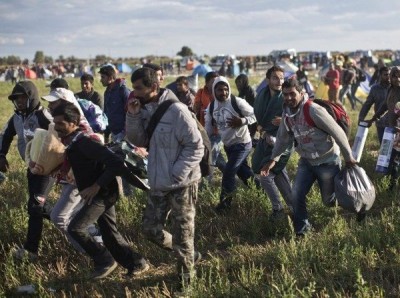Repulsion By Film: Anti-Refugee Propaganda in The Journey

The Danish government is doing it – as are others. The Australian government, however, may count itself as one of the first ones to take the concerted step to repel potential asylum seekers who arrive to Australian shores by boat with threatening films. There is nothing sophisticated about the script behind such messages. All insist on repulsion. All, ultimately, insist on the hostile world that awaits those seeking to take to the sea.
The Journey is the most recent installment in this campaign to use celluloid as a means of dissuasion. Commissioned by the propaganda specialists of the Australian immigration department (the full title being the Department of Immigration and Border Protection) in the time of the Abbott government, it highlights the risks facing those who undertake to travel across the Indian Ocean.
Put It Out There Pictures, the agency commissioned in this task, advertises itself as having a “reputation for creating film and television for a new ‘frontier’.” Clichéd in the extreme, the company’s site sups from the cup of a propaganda directive, hoping to enable audiences “to see the world through a new looking glass.”[1]
Sounding like a dull, procedural version of Leni Riefenstahl (and a lite version at that), the outfit also notes its role in “making hundreds of hours of television for local audiences in post-Taliban Afghanistan.” They work “with clients” to create pictures “within a framework of strong storytelling and high quality production values.”
Its production value is high; some of its acting is even deemed credible and suitable in character formation. Its contribution to the refugee debate is, however, minimal. Overwhelmingly, it constitutes a retreat from international obligation on the part of Canberra, a crude confession that other places are more suitable than prosperous, and a heavily fortressed Down Under.
As the producers of the program say, “The film aimed to educate and inform audiences in source countries about the futility of investing in people smugglers, the perils of the trip, and the hard line policies that await them if they do reach Australian waters.”
Techniques of omission and distortion thrive in the production. The dangerous environments for those leaving, in their political, military and social sense, is understated. Discussion of war zones is virtually absent, a mere whisper behind the motivations. Instead, there is a an auntie-like condescension that such individuals are purely driven by a desire to seek folly-filled adventure, brimming with New World aspirations to improve their bank balance.
Focus is shifted to matters more specific to Australia’s interests: a graphic insistence on drowning, for instance; shonky overcrowded boats as preludes to death at sea; poor safety and the elements. Perversely, the human dimension of such beings is inadvertently emphasised (the cruelty of separation, for instance), suggesting that such beings, instead of being detained for lengthy periods of time on Nauru or Manus Island, should be seen as subjects of mercy rather than objects of cruelty.
Its effect, garnered through broadcasts across Afghanistan, Iran, Iraq and Pakistan, has already been noted in some circles. “It was hard to watch,” claimed an 18-year-old tailor by the name of Ali Reza, as reported in The Guardian. “It made me very upset. I know they were actors, but these things really happen to Afghans.”[2] Whether the effect is to move such figures to not leave, is another matter.
The Immigration department is insistent that such filmography is vital in its quest to dissuade in order to save, while dumping on people smugglers with moral intensity. But behind that message lingers some dirty laundry and an industry of deception. It has enlisted, for instance, the services of Saad Mohseni, to market the film through his advertising arm, Lapis Communications.
Mohseni was himself a refugee who arrived in Australia with his parents in the 1980s a few years after the invasion of Afghanistan by the Soviet Union. Known as the “Rupert Murdoch of Afghanistan”, this can hardly be an encouraging endorsement for veracity. Mohseni’s links with the dark tycoon of manufactured news and make-believe is further hardened by 21st Century Fox’s minority shareholding in the Moby Group, which he founded.
This pedigree does not bother Mohseni, who counts himself a friend of Murdoch’s. Through a spokeswoman, Mohseni argued that the “idea and values around the film are grounded in addressing a very serious and tragic issue – with the ultimate objective of saving lives.”[3]
Craig Henderson, writing in The Illawarra Mercury (Mar 29) was suitably impressed, and disgusted, by the nature of the trailer, “meant to frighten the pants off people who already have the pants frightened off them every day when they wake up under a regime that enthusiastically embraces slaughtering civilians, violently oppressing women and torture.”[4]
The Australian satirical news program, The Weekly, even went so far as to suggest that a budget of $6 million ($4.35 million for production; $1.63 million for promotion) would go some way to reviving Australia’s film industry.[5] At the very least, it might engender a boom, a rush of inspiration for Australian “product”. After all, the combined budget of Wolf Creek, The Castle and Priscilla Queen of the Desert was actually exceeded in producing The Journey. Murdoch will be ecstatic at the news.
Dr. Binoy Kampmark was a Commonwealth Scholar at Selwyn College, Cambridge. He lectures at RMIT University, Melbourne. Email: [email protected]
Notes:
- http://putitouttherepictures.com/
- http://www.theguardian.com/australia-news/2016/mar/28/hard-to-watch-afghans-react-to-6m-australian-film-aimed-at-asylum-seekers
- http://www.smh.com.au/federal-politics/political-news/former-refugee-paid-to-promote-duttons-antirefugee-telemovie-20160401-gnwfy6.html
- http://www.illawarramercury.com.au/story/3816602/propaganda-oz-style/
- http://www.abc.net.au/tv/programs/weekly-with-charlie-pickering/

